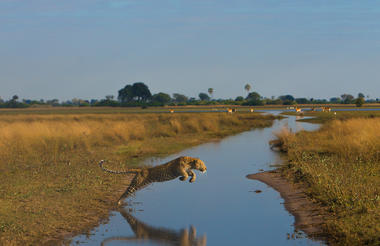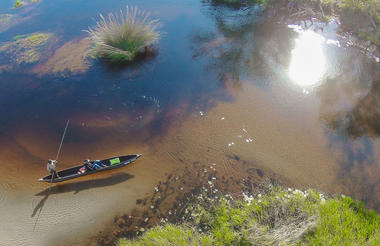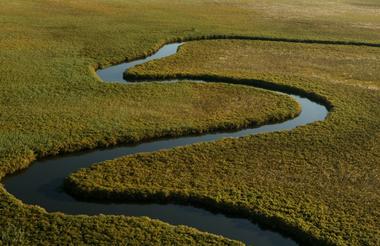Tucked away in the northeastern corner of Botswana, on the banks of the famous Chobe River, the quaint little town of Kasane rests on the doorstep of the spectacular Chobe National Park . There are no boundary fences separating the village from the park and game such as elephant and warthog are often spotted roaming around the town and hippos at times come onto land to help themselves to the lush grass of manicured lawns. Wildlife such as the elusive wild dog have been seen along the tar roads on the outskirts of town. Within Kasane behind the police station, an ancient baobab tree stands on display, once serving as a local prison. Visitors can look forward to a multitude of activities including game drives through the park, taking a sunset cruise down the Chobe River, visiting a local village or jumping on a day trip to the breathtaking Victoria Falls. Kasane is strategically located close to the Namibian, Zambian and Zimbabwean borders.

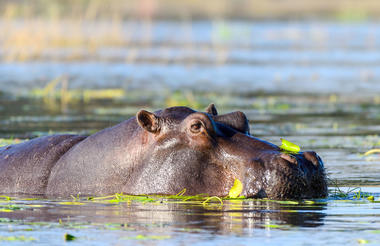
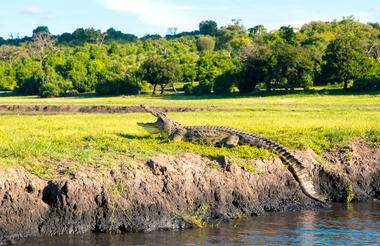
At Victoria Falls, the earth splits open and swallows one of Africa’s greatest rivers, the mighty Zambezi, creating the largest sheet of falling water on earth. As the water hits the narrow depths of the Batoka Gorge beneath, it blasts a cloud of mist skywards, lending the falls their local name ‘mosi-oa-tunya’ (the smoke that thunders). When the Zambezi is its fullest, the mist hangs a permanent raincloud above the falls, showering visitors on even the sunniest of days and visible for miles around.
Above the falls on the upper Zambezi, boats cruise the tranquil water at sunset while the distant spray catches the fading light downstream. Below the falls, the Batoka Gorge’s rocky walls funnel the lower Zambezi into a chain of world-class rapids, prime for white water rafting.
Aside from being a UNESCO world heritage site and a natural world wonder, Victoria Falls also forms a natural border between Zimbabwe and Zambia. The falls can be seen from both countries, and for the most part the same activities are offered on both sides, from helicopter scenic flights to village visits and souvenir shopping.
Whether your idea of getting away from it all is a relaxed high tea in colonial grandeur or a heart-stopping bungee jump off a bridge, Victoria Falls keeps both the faint of heart and the most insatiable of adrenalin junkies busy for days.
From Zambia, a side on view of the falls is on offer with views into the Batoka Gorge, as well as the possibility of perching yourself at the edge of the falls on the vertigo-inducing Livingstone Island.
From Zimbabwe, you’ll get a full-frontal view of three quarters of the falls’ 1.7km wide curtain of water from viewpoints and footpaths meandering through a rainforest kept hot and humid by the spray of the falls.
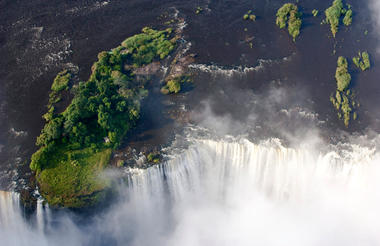
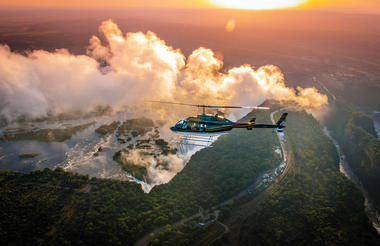
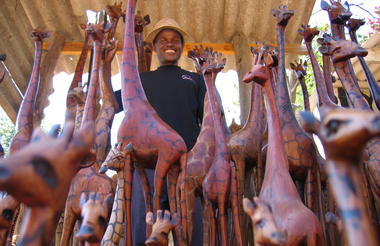
If you have dreamt of an Africa with expansive plains and wide horizons, where elephant and buffalo traipse in huge numbers towards waterholes and giraffe browse from flat topped acacias while a blazing sun sets behind them… you can find it in Hwange.
As Zimbabwe’s largest national park, Hwange has a sizeable reputation that it wholeheartedly deserves.
The sight of hundreds, if not thousands of elephants and buffalos streaming towards you as you sit at a waterhole is indescribable. There is nothing like the sound of elephants' peaceful rumbling or the deep thundering of buffalo hooves on hard ground when they spook, wary of lions that may lie in wait.
This sight and sound of a waterhole in the midst of pristine wilderness visited by huge numbers of animals is typical of Hwange. Beyond the sights and sounds, the feeling of Hwange is what will remain with you: awe and peace from spending time in a true, preserved wilderness.
Hwange’s diverse habitats mean that it offers large numbers of desert adapted, plains and woodland animals. The famed elephant population is one of the largest in the world and it has plentiful predator populations such as lion, leopard and cheetah. Hwange also boasts one of Africa’s last strongholds of endangered African wild dogs.
Hwange offers the opportunity to see a variety of rare antelope such as eland, sable, roan and if you are lucky the desert-adapted oryx (gemsbok).
Apart from the variety of species and its beautiful setting, Hwange is unique in its ease of access. The park begins a mere hour from Victoria Falls and there is a range of accommodation across every price point. The North typically offers a mix of private lodging and National Park chalets, as well as a well-maintained road network. Hwange’s more southern concessions are generally private, offering luxury lodges and camps.
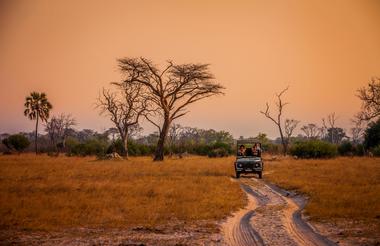
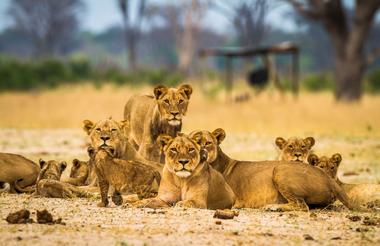
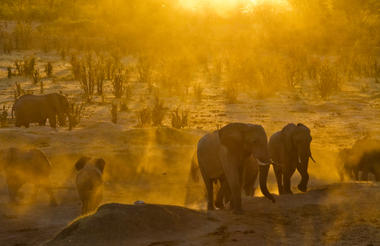
With balancing boulders, standing stones, massive monoliths and precariously perched pebbles; the granite formations of Matobo (also known as Matopos) hills are among the world’s most spectacular geology.
Matobo’s boulder-strewn hills have a rugged and timeless beauty of their own and it’s easy to see why humans have habituated them for thousands of years. Across their amphitheatre much of Zimbabwe’s history has played out. Here one can marvel at ancient Khoi-San rock art and visit Malindidzimu ‘The Hill of spirits’ a sacred site to indigenous peoples and the grave of Cecil Rhodes; an important reminder of the country's colonial past.
As you walk across granite monoliths you can feel the history beneath your feet. Many describe the spires and rock formations as ‘cathedral like’ making it easy to understand why the area has great spiritual and cultural significance to local people. This is the perfect location to explore on foot or on horseback. Follow ancient trails to breath-taking views or hidden caves adorned with beautiful and unique paintings of animals dating back as far as 20 000 years.
Matobo National Park’s main attraction is its natural beauty and historical significance; however, wildlife can also be seen throughout the park. The park is said to have the highest density of leopards in the world given its size, and with leopards having a natural preference for rocky habitats this fact is unsurprising. Don’t expect to see a lot of Matobo’s leopards however, as their secretive nature makes them hard to spot. Within the park is an "Intensive Protection Zone" where the best game viewing can be found, including a sizeable population of the highly endangered black and white rhinoceros, which are successfully breeding. The park also hosts numerous small species and magnificent birding, from the many rock dassies (hyrax) and colourful agama lizards that scramble across the rock faces.
The park’s location means that it makes an excellent stopover for people travelling between Zimbabwe’s East and Victoria Falls or Hwange National Park and begins a mere 35 kilometres from Bulawayo. There are luxury accommodation options within and around the park, as well as the basic but reliable National Park chalets, however it is close enough to Bulawayo to be visited as a day trip as well.
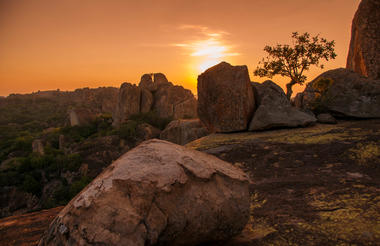
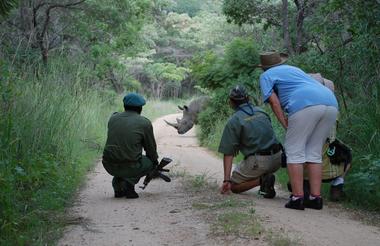

Francistown is the second largest urban centre of Botswana and is strategically placed as the gateway to the north with main roads leading to Gaborone, Zimbabwe and Kasane. The town (officially declared as a city now) is located on the confluence of the Tati and Inchwe Rivers and near the Shashe River (which is a tributary to the Limpopo). As once the centre of Southern Africa's first gold rush, Francistown is surrounded by old and abandoned mines as well as newer existing ones. Tourists travelling to different destinations of Botswana have a choice of several Lodges and Hotels that can provide stopover accommodation. There are also a few malls or shopping centres, one of the biggest hospitals in Botswana, a railway line that links the city with Harare (the capital city of Zimbabwe) and a domestic airport with two runways located two kilometers from the city.

The quirky village of Gweta doesn’t offer the traveller a lot as a destination in its own right and is best visited as a jumping off point for the Makgadikgadi Salt Pans further south. For travellers interested in exploring Gweta, there are a few traditionally painted rondavels to be found on the village’s sandy back roads and village tours can be organised to see the local school, kgotla (traditional court), cattle posts and to sample traditional village fare. The Makgadikgadi Salt Pans are around two hours from Gweta Village by road and the drive requires a 4WD. Due to the lack of signposts and the distance from Gweta, visitors are advised to book a pre-organised excursion out to the salt pans before they arrive.



Situated along the banks of the Thamalakane River, in the North-West District of Botswana, Maun, a term that derives its name from the San language, meaning "the place of reeds," serves as the administrative town center of Ngamiland. Maun is notoriously known as a "Frontier" town, and is referred to as the 'gateway' to the Okavango Delta and Moremi Game Reserve as most tourists enter these destinations through this buzzing town.
Although classified as one of the fastest growing towns in Botswana, and boasting one of the busiest airports in Southern Africa, Maun still retains much of its old/traditional (village-like) character, which encompasses the old judicial court of chiefs who are still active. Reed and mud hut infrastructures are seen in and around town as well as donkeys/carts and livestock. However, numerous hotels, lodges, bed and breakfasts, shopping malls, post offices, a museum and a big hospital are available too. Maun also serves as the headquarters for the safari industry, tour operators and air charter companies that offer trips into the Okavango Delta and National Parks such as Moremi Game Reserve, Khwai, Savute, Makgadikgadi, Chobe, Nxai Pan to name a few, as well as monumental historical sites like the Tsodilo Hills. Opportunities to visit nearby cultural villages can also be arranged from this central point.
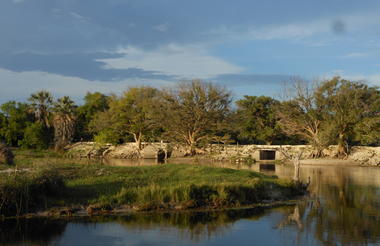


The Okavango Delta is where the wild things are: an immense, waterlogged oasis alive with elephants and birdlife, adrift in the middle of Kalahari sands. The real magic of the Delta lies in its water, trickling through from far away highlands, and spreading across the channels and floodplains.
During winter in the Kalahari, when the sun has baked the earth bare and turned the desert its driest, water fills the Okavango; transforming the floodplains into a Noah’s Ark of African wildlife.
As the water brings life to the delta, its local residents shape and recreate it. Termites slowly build mounds into islands, germinated with palm trees by passing elephants. Waterways open and close on the whim of wide-bottomed hippos, carving out channels where they crash through reeds, and leaving room behind them for exploration by mokoro.
The Okavango has many faces, which change throughout the year, prompted by that most unpredictable diva of all: the weather. Water levels rise and drop, expanding and shrinking islands, while animals move where the life is easiest and the grass greenest. In a few days, a sandy road driven by vehicle can become a waterway of unknowable depth, prompting a safari by boat instead.
Where and when you stay in the Okavango Delta will hugely influence what you do in the bush each day, the animals you’re most likely to see and finally, the safari experience you’ll have.
The delta’s watery heart is best discovered by mokoro through shallow channels and floodplains, as well as crossing the islands on foot. For less water and more of the big game, visit a camp on its drier edges (including Moremi Game Reserve and the Khwai Community Area), jump on a vehicle and seek out the animals hiding in the woodlands.
